Key takeaways:
- Equal pay advocacy aims to ensure equal compensation for individuals regardless of gender, race, or other characteristics, addressing hidden disparities caused by systemic barriers.
- Engaging with diverse communities is essential for effective advocacy, as it brings forth unique perspectives and stories that highlight the complexities of wage disparities.
- Building relationships with community leaders through active listening and consistency fosters collaboration and strengthens collective efforts towards equal pay.
- Measuring engagement and impact should include both quantitative metrics and qualitative feedback to understand the effectiveness of advocacy efforts and inspire ongoing dialogue.
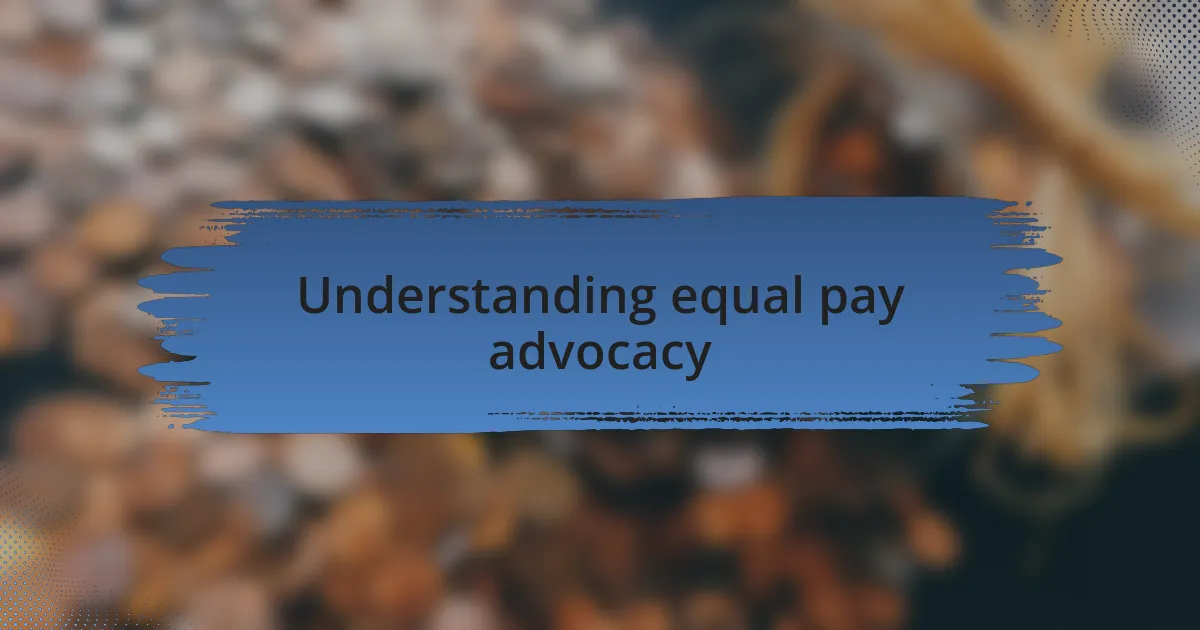
Understanding equal pay advocacy
Equal pay advocacy is fundamentally about ensuring that individuals receive the same compensation for equal work, regardless of their gender, race, or other characteristics. I remember an incident when a friend shared her discovery that she was earning significantly less than a male counterpart for the same role. It made me realize how hidden disparities can create lasting impacts on individuals’ lives and livelihoods.
When we talk about equal pay, it’s crucial to understand the systemic barriers that contribute to these inequalities. Have you ever considered how deeply ingrained stereotypes can influence hiring and promotion decisions? I’ve seen firsthand how unconscious biases affect performance evaluations, sometimes favoring one group over another, which ultimately perpetuates the cycle of inequality.
Engaging with diverse communities in this advocacy is not just beneficial; it is essential. I often reflect on the conversations I’ve had with women from various backgrounds who have bravely shared their stories of wage disparity. These discussions highlight the unique struggles and perspectives that need to be heard, making it clear that equal pay advocacy must be inclusive and representative to truly make an impact.
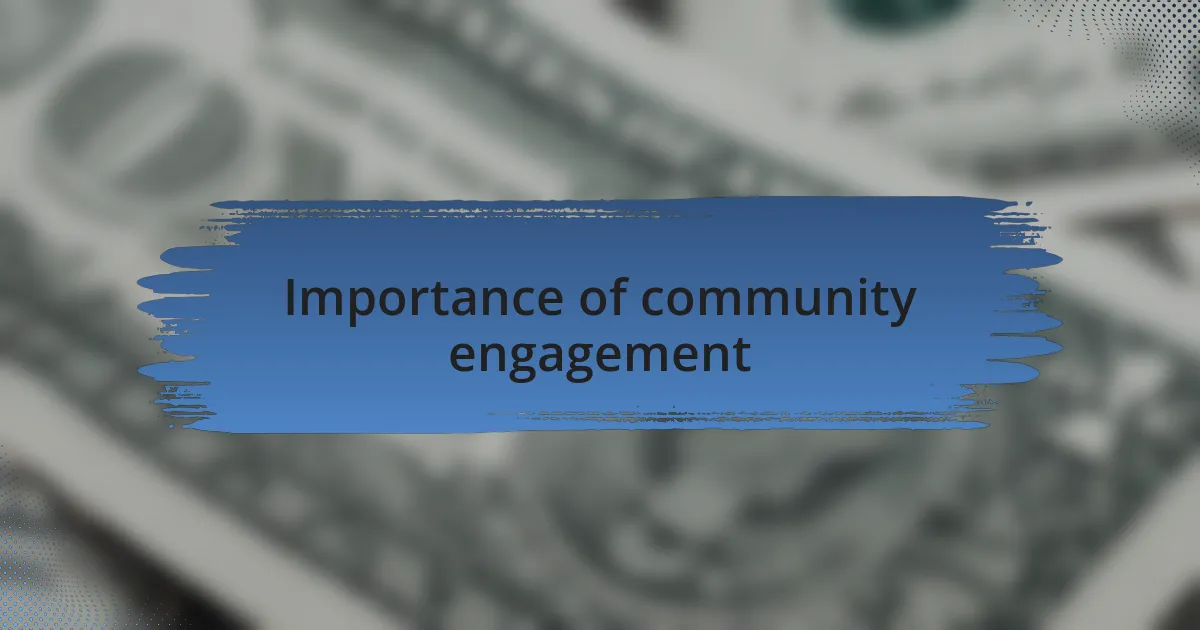
Importance of community engagement
When I think about community engagement in equal pay advocacy, I realize it acts as a bridge connecting various perspectives. During one of my workshops, a participant shared her experience about how cultural differences shaped her understanding of worth in the workplace. It struck me that without listening to these unique narratives, we risk overlooking critical factors that influence wage disparities.
Additionally, the impact of community involvement can’t be underestimated. I recall a time when a local organization partnered with us to host an event focusing on wage equity. The diverse voices that emerged during this gathering brought forth not just statistics, but powerful stories that resonated with everyone. It was a reminder that advocacy is more than numbers; it thrives on human connections.
Ultimately, engaging with diverse communities allows us to challenge assumptions and foster empathy. Have you ever felt moved by a story that changed your perspective on an issue? I know I have. By actively listening and collaborating with varied groups, we enrich our understanding and create more effective strategies for combating pay inequality.
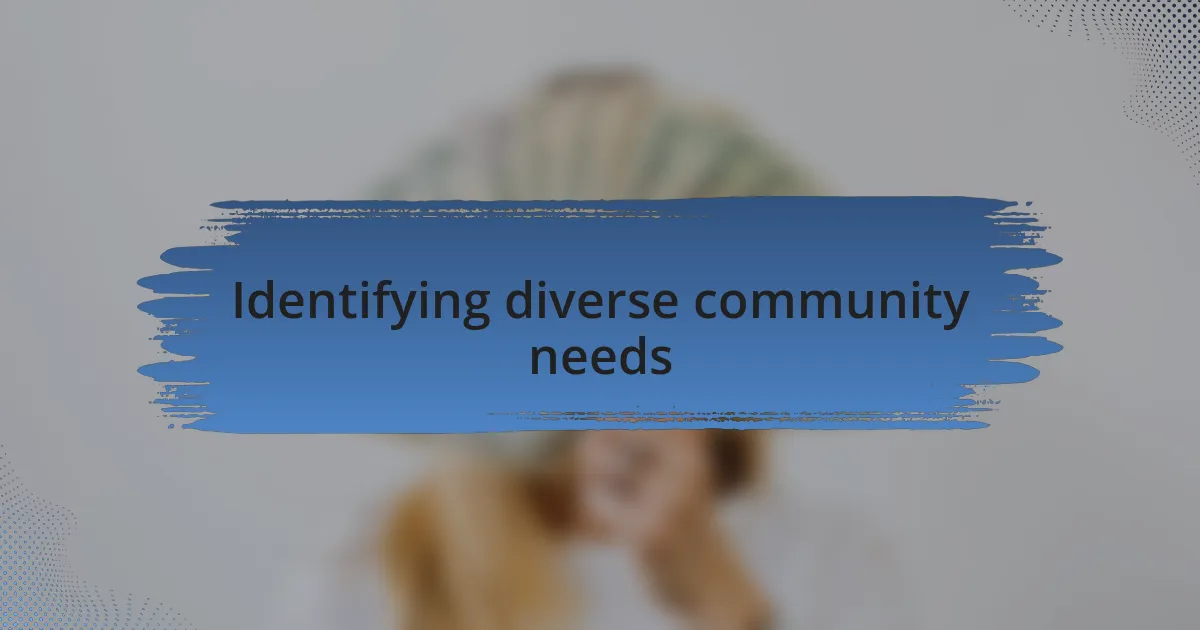
Identifying diverse community needs
Identifying the unique needs of diverse communities begins with open dialogue. I remember attending a community forum where individuals from various backgrounds shared their experiences with wage gaps. Hearing a small business owner express frustration about her inability to pay fair wages due to her marginalized status made me realize that economic barriers are often intertwined with deep-rooted societal issues.
In my experience, the most effective way to gauge community needs is through surveys and focus groups tailored to specific demographics. I once facilitated a focus group for immigrant workers who faced language barriers and workplace exploitation. This firsthand interaction revealed that many were unaware of their rights, a critical need that went unheard until we created a space for their voices. How can we expect to advocate effectively if we don’t truly understand their struggles?
Listening goes beyond just hearing words; it requires empathy and a readiness to adapt our strategies. During a workshop designed for + individuals, I observed the participants addressing not only pay inequities but also the lack of inclusive workplace policies. Their insights reshaped my approach to advocacy, proving that recognizing diverse community needs is essential to forging a path toward equity. Isn’t it essential to ensure every voice is not only heard but valued?
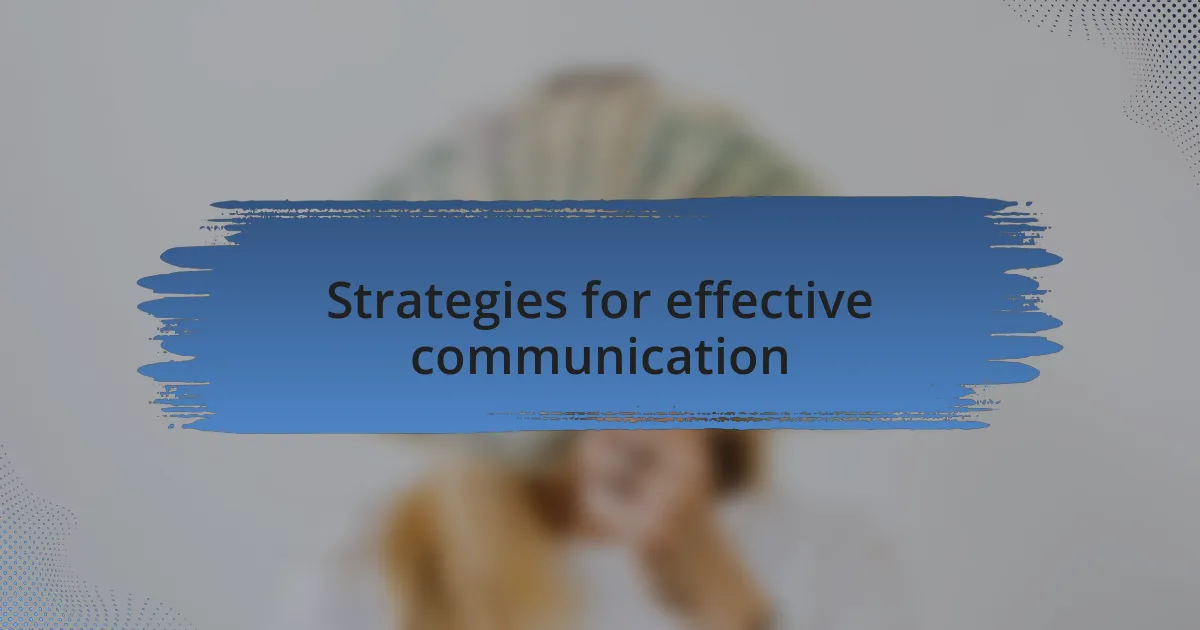
Strategies for effective communication
Effective communication starts with building trust within diverse communities. I recall attending a neighborhood meeting where community leaders emphasized the importance of transparency when discussing equal pay initiatives. By sharing both successes and challenges openly, we created a sense of shared purpose that encouraged more candid conversations about sensitive issues.
Utilizing multiple communication channels is crucial for reaching different audience segments. In my work, I discovered that a mix of social media, community newsletters, and in-person gatherings ensures that my messages resonate widely. I once created a simple infographic that clarified complex wage concepts, and the positive feedback from various community members showed me that clear, visual communication can bridge educational gaps.
Engagement also thrives on responsiveness. After hosting a town hall, I made it a point to follow up with participants through personalized emails, acknowledging their contributions. This not only affirmed their input but also fostered a culture of ongoing dialogue. Isn’t it fascinating how a little acknowledgment can transform a one-time event into a lasting partnership?
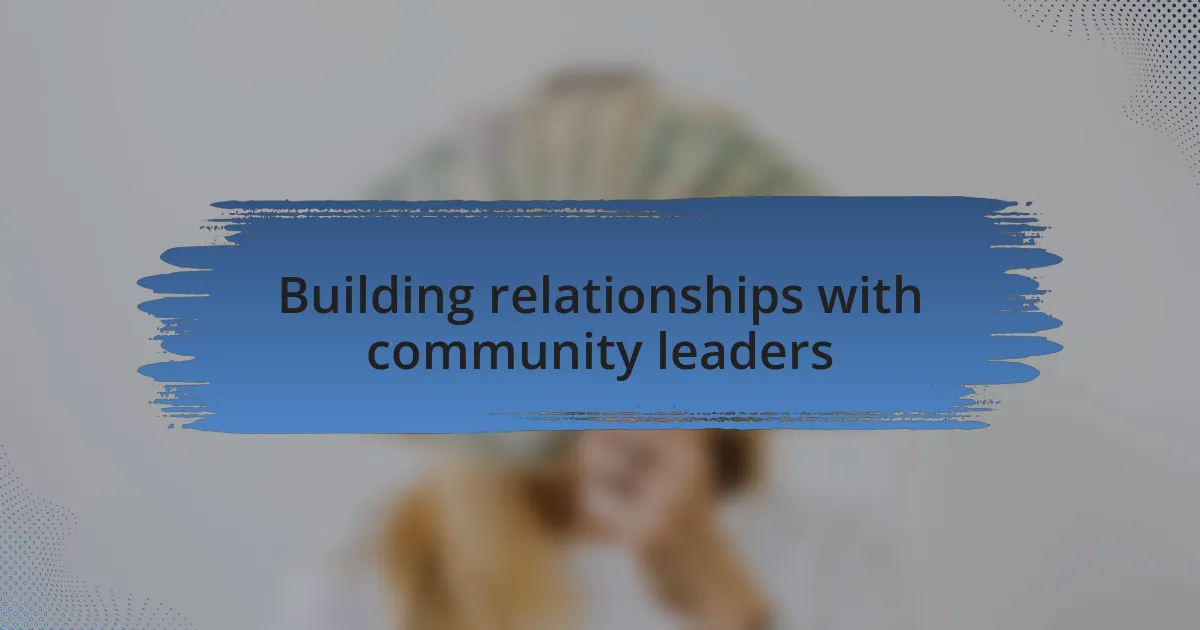
Building relationships with community leaders
Building relationships with community leaders requires an investment of time and genuine interest. I remember attending a local forum where I introduced myself to a leader from a different demographic background. Our conversation unfolded over coffee, where we shared our respective experiences and challenges in advocating for equal pay. Those moments of vulnerability established a connection that later paved the way for collaboration on joint initiatives.
Once I realized the impact of active listening, my approach to engaging leaders shifted dramatically. During a focus group on wage disparities, I made it a point to ask open-ended questions and really listen to the concerns expressed by attendees. Their insights often provided a different lens through which to view equal pay issues. The empathy that emerges from truly understanding another leader’s perspective is not just enlightening; it builds an invaluable rapport that can enhance collective efforts.
Being consistent is vital in maintaining these relationships. I recall sending out regular updates and check-ins to the community leaders I worked with after ongoing campaigns. These small gestures demonstrated my commitment to our shared goals. It’s amazing how a simple message can affirm your dedication and keep the lines of communication open. Have you ever considered how consistency can transform a fleeting connection into a strong alliance?
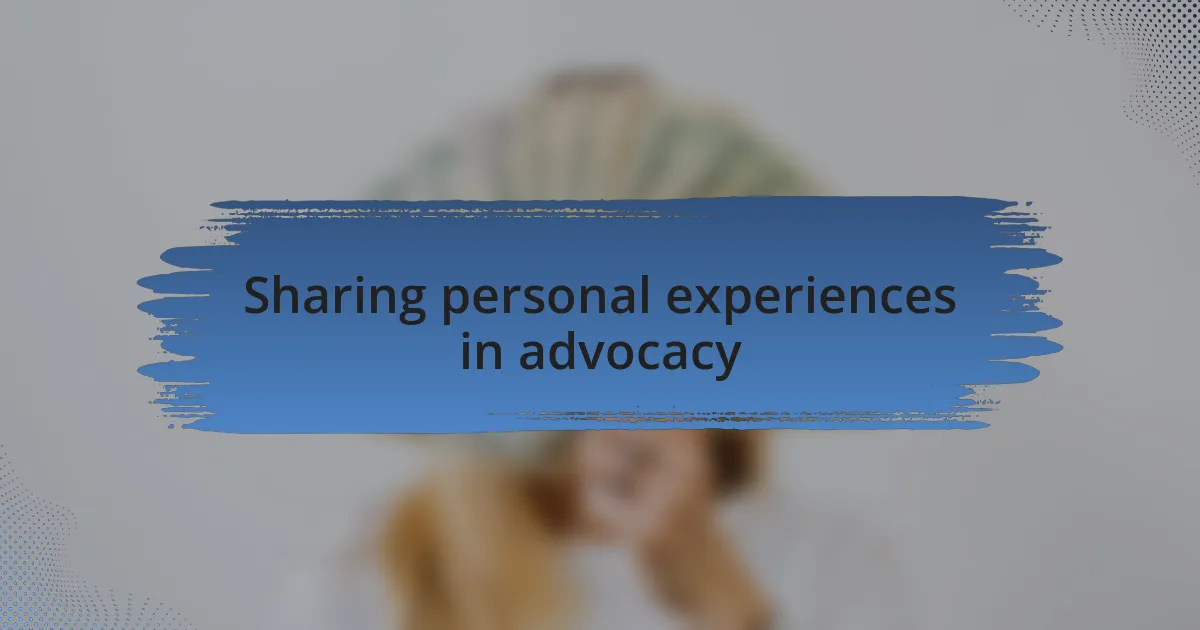
Sharing personal experiences in advocacy
Sharing my personal experiences in advocacy has proven to be a powerful tool for connecting with diverse communities. I remember a particular workshop I facilitated where I opened up about my own struggles with wage inequality. The courage it took to share my story not only resonated with attendees but encouraged others to voice their own experiences. Have you ever felt that moment when vulnerability creates an atmosphere of trust? It’s in these shared admissions where I often find common ground that drives our collective mission forward.
In another instance, I participated in a panel discussion focused on equal pay for women of color. I shared the challenges I faced navigating workplace dynamics while balancing cultural expectations. The candid exchanges that followed among panelists and the audience felt transformative. It highlighted how personal narratives can shine a light on overlooked issues and amplify the voices that need to be heard. How often do we stop to reflect on the power of our stories and their potential to spur action?
I’ve also taken the step of documenting my advocacy journey on social media, sharing the highs and lows of our collective fight for equal pay. The feedback I receive from individuals who relate to my experiences motivates me to keep going. Every message or comment serves as a reminder that it’s not just about the issue at hand; it’s about building a community of advocates who feel seen and supported. How fulfilling is it to know that your voice can inspire others to stand up as well?
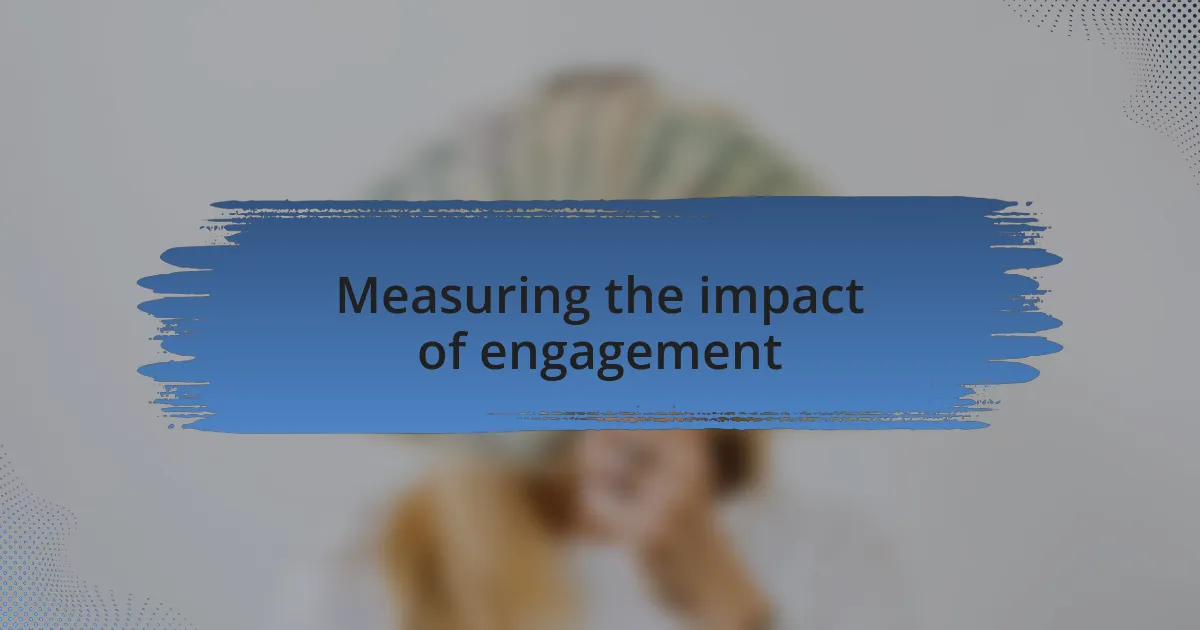
Measuring the impact of engagement
Measuring the impact of engagement is crucial for understanding how well we are resonating with diverse communities. I once used follow-up surveys after an advocacy event, seeking feedback on whether participants felt more empowered to speak out about pay equity. The responses were eye-opening; many attendees reported feeling more confident and equipped with knowledge, which confirmed that our engagement efforts were hitting the mark.
Additionally, tracking social media interactions can be a valuable metric. When I noticed a significant increase in shares and comments after posting an advocacy video, it was a clear sign that our message was not just reaching people, but also sparking conversations. Reflecting on these metrics, I often wonder: how do we truly gauge the depth of engagement beyond just numbers? It serves as a reminder to look for qualitative outcomes alongside quantitative data.
Lastly, I find that creating a space for honest dialogue fosters a deeper sense of community. At a recent roundtable, I asked participants to share how our discussions influenced their views on equal pay. Hearing firsthand accounts of how these engagements encouraged action in their own circles was not only validating but inspiring. This communal feedback loop emphasizes that measuring impact is not just about what we see on paper, but also about transforming lives.